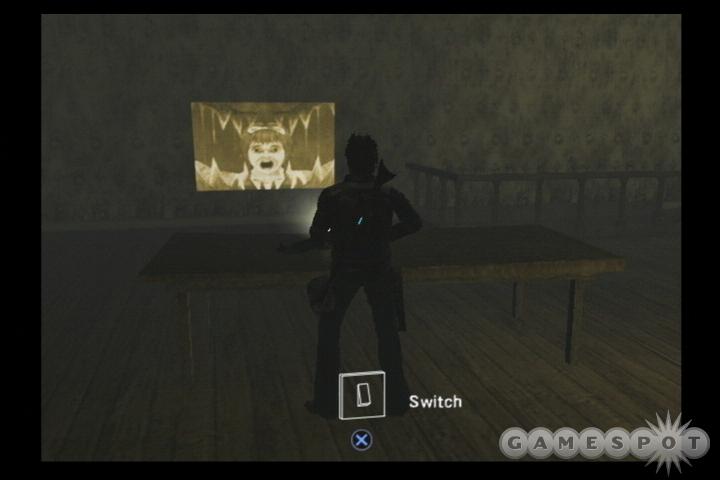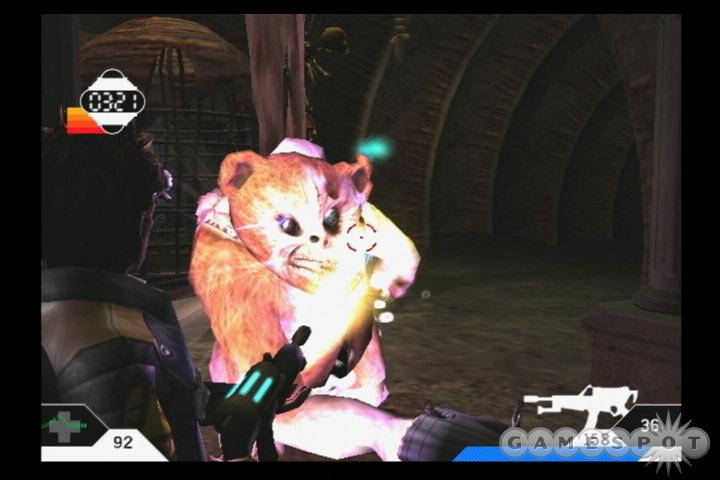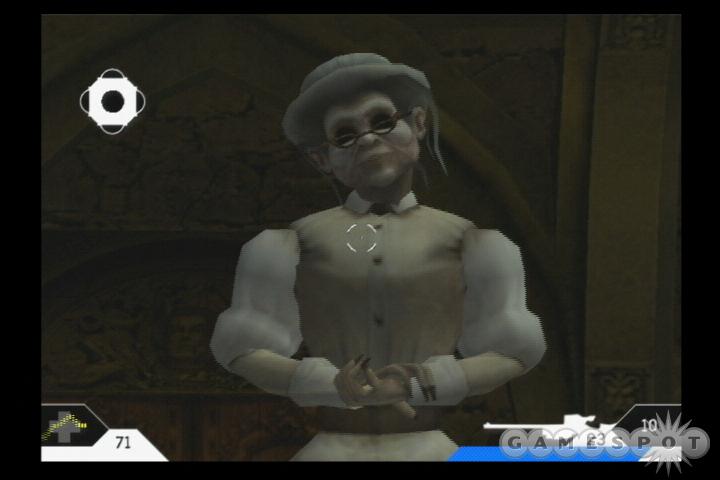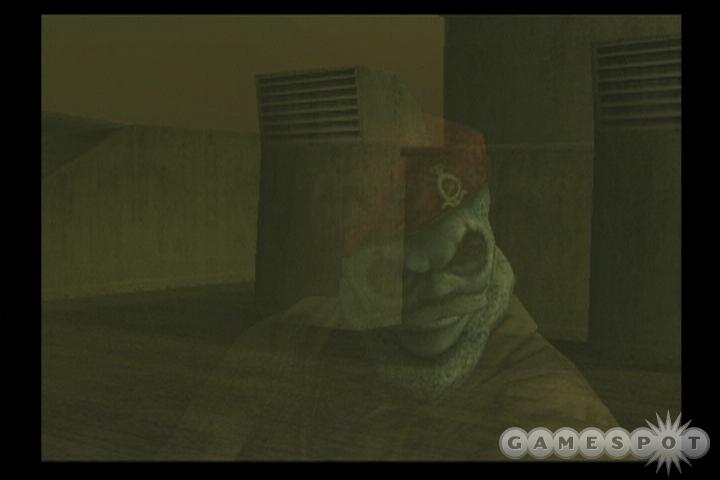Sony Europe's Ghosthunter is a rare breed of third-person action game. A cursory examination of what it has to offer would show a fairly by-the-numbers action game with pretty graphics, a shallow, rudimentary combat system, and too many linear and dull puzzles for its own good. However, upon second glance, the game reveals far more than what you would initially discover. In fact, over time, Ghosthunter proves itself to be a wonderfully atmospheric game that balances creepy and campy better than most other games that have tried. Through its impressive graphics engine, excellent use of voice talent, and well-told storyline, Ghosthunter is a game that should absolutely be played by anyone who enjoys a good, creepy action romp.

Ghosthunter puts you in the role of Lazarus Jones, a slightly naïve country boy who has just transferred into the rough-and-tumble Detroit police department. On his first assignment, Lazarus and his partner, Anna Steele, are sent to investigate an abandoned high school, which is purported to be haunted. After an introduction in which the usual action-movie-style tension is set up between the two (think Lethal Weapon), they split up, searching the high school for anything suspicious. It doesn't take long for Lazarus to start hearing voices, and eventually, he stumbles upon a bizarre array of machinery in the school's basement. Faster than you can say Walter Peck, Lazarus presses the wrong button on the machine, unleashing a horde of unhappy spirits upon the world, one of whom (a particularly grotesque-looking man of medieval dress and mannerism, named Hawksmoor) even goes so far as to kidnap Lazarus' partner, Steele. Of course, this simply will not stand, and it is then up to you, as Lazarus, to go out and capture all those kooky, creepy ghosts you've let loose and get your partner back.
From the get-go, it's pretty clear that the primary inspiration for Ghosthunter came from the famed Ghostbusters film franchise. For instance, some of your tools of the trade include a crazy contraption that lassos a ghost using spectral energy, as well as a ghost grenade to trap the fallen spirits (and eventually contain them in that wacky array that looks an awful lot like a bigger version of the old Ghostbusters containment unit). In addition, you'll find yourself in a number of situations that are pretty reminiscent of the Ghostbusters films, such as one sequence where you're interacting with a ghostly librarian poltergeist who eerily demands silence when you enter a school library and another scene where you have to quietly follow a "howler" spirit that looks a lot like the wacky, ghostly sidekick Slimer. Then there's the main bad guy, Hawksmoor--one look at him will likely have you yelling, "He is Vigo! You are like the buzzing of flies to him" at your TV. However, for as much as Ghosthunter derives from older tales of ghostbusting--er, ghosthunting--it uses its inspirations very well and manages to create something pretty original.
The primary reason Ghosthunter works is that it seems to have a very firm grip on what it wants to be. It knows it isn't scary enough to really fit into the survival horror genre, but it's too creepy to be considered just a standard action game. Ghosthunter falls squarely in between the two, and it manages to keep an almost uncanny balance all throughout the game. You'll never find yourself jumping out of your seat in fright; rather, you will find yourself having a legitimate feeling of uneasiness in many situations. The game is also good about not counteracting these feelings of dread with too many gags or goofy moments. Yes, the game has its campy sections, and the story is wholly silly the entire way through, but the story is paced well enough to maintain a good atmosphere. You're creeped out when you're supposed to be creeped out, and you smile when you're supposed to smile, which is more than you can say for most games that attempt to strike this careful balance.

Most of Ghosthunter's missions and objectives involve Lazarus' travels through an astral portal (conveniently located in the basement of the school, right next to the array) to strange locations scattered across the globe. Without delving into too many spoilers, you come to learn that these locations were once the regular "haunts" of the spirits you set free. You'll find yourself in a number of different, creepy locations, including a flooded ghost town on the edge of civilization, a rickety old ghost ship, and an abandoned prison island. What's especially cool about these environments and the world the game presents you with is that because of its supernatural stylings, there are no rules to speak of. One moment you'll be standing in front of a painting, and then the next it will open up a portal to what feels like an alternate-reality version of the place you were just standing in. The game features more than its share of bizarre, reality-bending sequences that are just plain cool, and they help present a much more unpredictable picture than you might expect.
This is not to say that the whole game is unpredictable--unfortunately, this is hardly the case. The mission objectives you're presented with in Ghosthunter never really transcend the age-old "kill all the bad guys and pick up necessary items along the way" sort of objectives. The whole game is quite linear in that while there's plenty to see and do, the path you must take in order to see it all is quite obvious at all times. This is largely thanks to the game's terribly dimwitted puzzles.
Every puzzle in Ghosthunter is pretty much dead on arrival. Anyone with cognitive abilities of any kind should never, ever get stuck for more than a couple of minutes in any section of the game. This is because the game never really tries to trip you up in any meaningful way, and 99 times out of 100, the logical path is the correct one. The only time the game tries to change it up is with its occasional Astral puzzles. You see, when you let all hell loose at the beginning of the game, your body was inhabited by the spirit of a not-quite-dead young woman by the name of Astral. Scattered throughout each level are Astral points. By pressing the X button while standing in the middle of one, you can summon Astral and control her. As you play, you'll earn new abilities for Astral, such as one that allows her to possess enemy spirits or another that gives her the ability to blast away debris that might be blocking your path. While this is a pretty good idea that breaks up the action, the puzzles the game sets up for the Astral sequences are even simpler than the ones you solve as Lazarus and are even more linear in design. When you see an Astral point in the game, you know exactly what you have to do before you've even summoned her.

On the plus side, the combat portion of Ghosthunter's gameplay is far better than its puzzles. Lazarus has a number of weapons at his disposal, ranging from more corporeal weaponry, such as a pistol or a shotgun, to weapons specifically designed for ghosthunting, like a pulse rifle that is powered by spectral energy. When you encounter an enemy spirit in the game, your first task is to enter combat mode by pressing the R1 button. Once you do this, Lazarus goes from his usual stance into a more combat-oriented stance, complete with a targeting reticle and strafing ability. You'll then want to toss a ghost grenade at the enemy by pressing the R2 button. Once it embeds itself in the nasty ghoul, it will bring up a life meter. Ghosts are vulnerable to all weapon types, but since they're already dead, you can't actually kill them. Rather, by depleting their life meter, you eventually weaken them to the point where they can be trapped by the ghost grenade and sucked in by a rather spectacular visual effect.
Combat mode can be a bit tricky. When you're fighting multiple enemies, you can't throw multiple grenades, so your focus tends to stick with whatever spirit you have tossed your grenade at. You can, of course, still shoot enemies that haven't been sacked with the ghost grenade, but it can be hard to keep track of which one you're supposed to be shooting at since a lot of the multi-enemy situations feature enemies that look totally alike. Fortunately, the game rarely throws more than four or five enemies at you at once, so you won't often be horribly outnumbered. Of course, there are some enemies that can't be trapped and still others that, while trappable, require you to use a different sort of strategy to defeat them.
For enemies that can't be trapped at all, you simply need to fire a gaggle of shots to eliminate them. However, certain bosses have to be trapped a very specific way. For example, one boss is actually a pair of bosses that are semi-attached to one another. They don't particularly like one another, and in order to get them weak enough to trap them, you have to continually draw them toward one another until they start attacking each other. These few respites from the otherwise point-and-shoot style of gameplay that makes up much of Ghosthunter are most certainly welcome and add a layer of creativity to what is otherwise a pretty straightforward shooter.
Significantly more impressive than Ghosthunter's gameplay elements are its visuals. Ghosthunter is an immensely detailed and atmospheric game, with an incredible graphics engine to back it up. Every aspect of Ghosthunter's world absolutely exudes spookiness. The designs for the various spirits, though a tad repetitive when it comes to the more typical grunt enemies, are actually quite inspired. Ranging from your typical aeriform spooks, to more grotesque creatures, like the spirit of a little girl with a teddy bear that morphs into a gigantic, demonic teddy bear that swings what looks like the little girl's corpse at you like a rag doll, Ghosthunter's ghosts run the gamut from typical spooky to just plain disturbing. The in-game environments emulate the proper feelings of creepiness just as well. Little details, like the spooky, sunset haze surrounding the ghost town environment and the dank, utterly uneasy set designs of a haunted mansion, really set the mood beautifully.
The visual engine Sony Europe developed for Ghosthunter really helps bring the visual aesthetics to life (or death, as it were) with incredible results. The amount of detail put into the character models alone is almost staggering. One up-close look at Lazarus is all you really need to understand the amount of work that has been put into every character model. The cutscenes are transparently CG in that they easily look like they could be in-engine. They're well directed too and are never boring to watch. Aside from occasional hitches with the frame rate, you shouldn't notice any technical problems in Ghosthunter, and you'll barely notice any loading time. When the game loads up a specific world, the only times you'll encounter a load during that level are in between cutscenes, and those are rarely more than a second long. Otherwise, the transitions between sections are practically seamless.

Ghosthunter also shines in the audio department. With a voice cast that features the likes of veteran voice actor Rob Paulsen, Terminator 2 and Ali star Joe Morton, and famed British actor Sir Michael Gambon, the voice-acting aspect of the game is pretty much as close to flawless as you can get. The writing isn't always perfect, but when it works, the dialogue flows brilliantly. The music department is similarly wonderful, featuring a whole host of original scores that perfectly emulate the proper mood settings. When an attack is on, the music quickly kicks it up a notch to add to the frenzy of the situation, and when you're floating around in control of Astral, the game will shift to a more ethereal, relaxing score. All of the in-game sound effects are very well put together. The different ghost-catching weapons have some pretty unique sounds, and the roars of the various spirits have a pretty chilling ring to them. All around, the game's sound design adds to the atmosphere brilliantly.
Ghosthunter isn't a game that will appeal to hardcore survival horror aficionados, nor is it going to have much appeal to anybody who wants serious challenge or longevity out of their action games. The fact is, Ghosthunter is a very easy game that shouldn't take more than eight or nine hours to complete, and there isn't really anything to bring you back to the game once you're done with it. However, Ghosthunter is still a very enjoyable experience for as long as it lasts. Most players should be able to forgive its relative simplicity thanks to its excellent ambiance and entertaining characters and storyline. You definitely won't find yourself challenged by anything Ghosthunter has to offer, but thankfully, the ride the game takes you on is thrilling enough to make it so you won't even care.